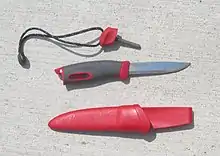Ferrocerium
Ferrocerium is a synthetic pyrophoric alloy that produces hot sparks that can reach temperatures of 3,000 °C (5,430 °F) when rapidly oxidized by the process of striking the rod, thereby fragmenting it and exposing those fragments to the oxygen in the air. This property allows it to have many commercial applications, such as the ignition source for lighters (where it is often known by the misleading name "flint"), strikers for gas welding and cutting torches, deoxidization in metallurgy, and ferrocerium rods (also called ferro rods, flint-spark-lighters and wrongly "flint-and-steel" as this is the name of a different type of lighter using a section of high carbon steel and a natural flint). Due to ferrocerium's ability to ignite in adverse conditions, rods of ferrocerium are commonly used as an emergency combustion device in survival kits.[1]

Ferrocerium was invented in 1903 by the Austrian chemist Carl Auer von Welsbach. It takes its name from its two primary components: iron (from Latin: ferrum), and the rare-earth element cerium.[2] The pyrophoric effect is dependent on the brittleness of the alloy and its low autoignition temperature.[3]
Use


While ferrocerium-and-steels function in a similar way to natural flint-and-steel in fire starting, ferrocerium takes on the role that steel played in traditional methods: when small shavings of it are removed quickly enough the heat generated by friction is enough to ignite those shavings, converting the metal to the oxide, i.e., the sparks are tiny pieces of burning metal. The sparking is due to cerium's low ignition temperature of between 150 and 180 °C (302 and 356 °F). About 700 tons were produced in 2000.
Comparison with natural flint
Ferrocerium bears no chemical relationship to the rock flint. The similarity lies in the fact that both materials have historically been used to generate sparks. In traditional flint-and-steel fire-starting systems (using natural flint), the hard flint rock strikes tiny iron particles from the steel, which ignite due to frictional heating. This is essentially the opposite of the mode of operation of a ferrocerium "flint" in a modern lighter, where the hardened steel wheel strikes particles of ferrocerium from the "flint". In a classic flint and steel system, it is the steel that burns, while in a ferrocerium system, it is the ferrocerium.
Flint spark lighter
A flint spark lighter (sometimes just called a spark lighter, striker, or flint lighter) is a type of lighter used in many applications to safely light a gaseous fuel to start a flame. It is most commonly used for Bunsen burners and for Propane and oxyacetylene welding torches.
A flint spark lighter works by rapidly rubbing a small piece of ferrocerium upon the sharp edge of any substance that is harder than the ferrocerium rod. Carbon steel works better than most other materials in much the same way flint and steel are used. This manual rubbing action, done by squeezing the handle, creates a spark, which ignites the gaseous fuel.
As tinder-igniting campfire starter rods it is sold under such trade names as Blastmatch, Fire Steel and Metal-Match for survivalists and bushcraft hobbyists. Some manufacturers and resellers incorrectly call them "magnesium" rods. Some manufacturers combine a strip of ferrocerium along with a strip of magnesium in the same item, to be used by scraping off flakes of magnesium and then striking the ferrocerium with a knife. The sparks from the ferrocerium will ignite the magnesium, which will in turn ignite the tinder.
Composition
It is also known in Europe as Auermetall after its inventor Baron Carl Auer von Welsbach. Three different Auermetalls were developed: the first was iron and cerium, the second also included lanthanum to produce brighter sparks, and the third added other heavy metals. In the Baron von Welsbach's first alloy, 30% iron (ferrum) was added to purified cerium, hence the name "ferro-cerium".
A modern ferrocerium firesteel product is composed of an alloy of rare-earth metals called mischmetal (containing approximately 20.8% iron, 41.8% cerium, about 4.4% each of praseodymium, neodymium, and magnesium, plus 24.2% lanthanum.[4]) A variety of other components are added to modify the spark and processing characteristics.[1] Most contemporary flints are hardened with iron oxide and magnesium oxide.
| Element | Iron | Cerium | Neodymium | Praseodymium | Magnesium | Lanthanum |
|---|---|---|---|---|---|---|
| Fraction | 20.8% | 41.8% | 4.4% | 4.4% | 4.4% | 24.2% |

See also
References
- Reinhardt, Klaus and Herwig Winkler (2000). "Cerium Mischmetal, Cerium Alloys, and Cerium Compounds". In Wiley-VCH, Ullmann's Encyclopedia of Industrial Chemistry. John Wiley and Sons. doi:10.1002/14356007.a06_139.
- van Weert, Ad, Joop Bromet, Alice van Weert (1995). The Legend of the Lighter. New York: Abbeville Press, p. 45.
- Hirch, Alcan (1920). "Ferrocerium, its Manufacture and Uses", Iron Age 106 (Sep. 2): 575–576.
- Cerium flint rod product description Archived 2008-10-24 at the Wayback Machine
External links
- Jorgenson, John D.; Corathers, Lisa A.; Gambogi, Joseph; Kuck, Peter H.; Magyar, Michael J.; Papp, John F.; Shedd, Kim B. "Minerals Yearbook 2006: Ferroalloys" (PDF). United States Geological Survey. Retrieved 2009-04-24.
